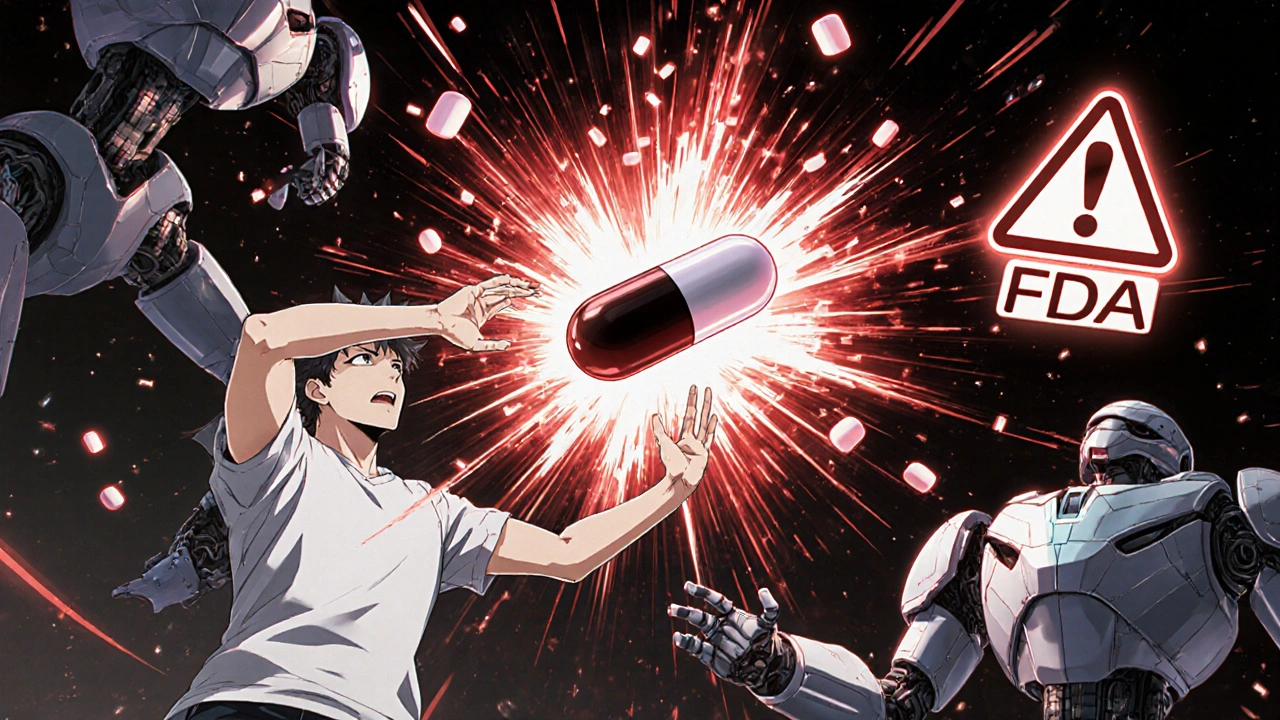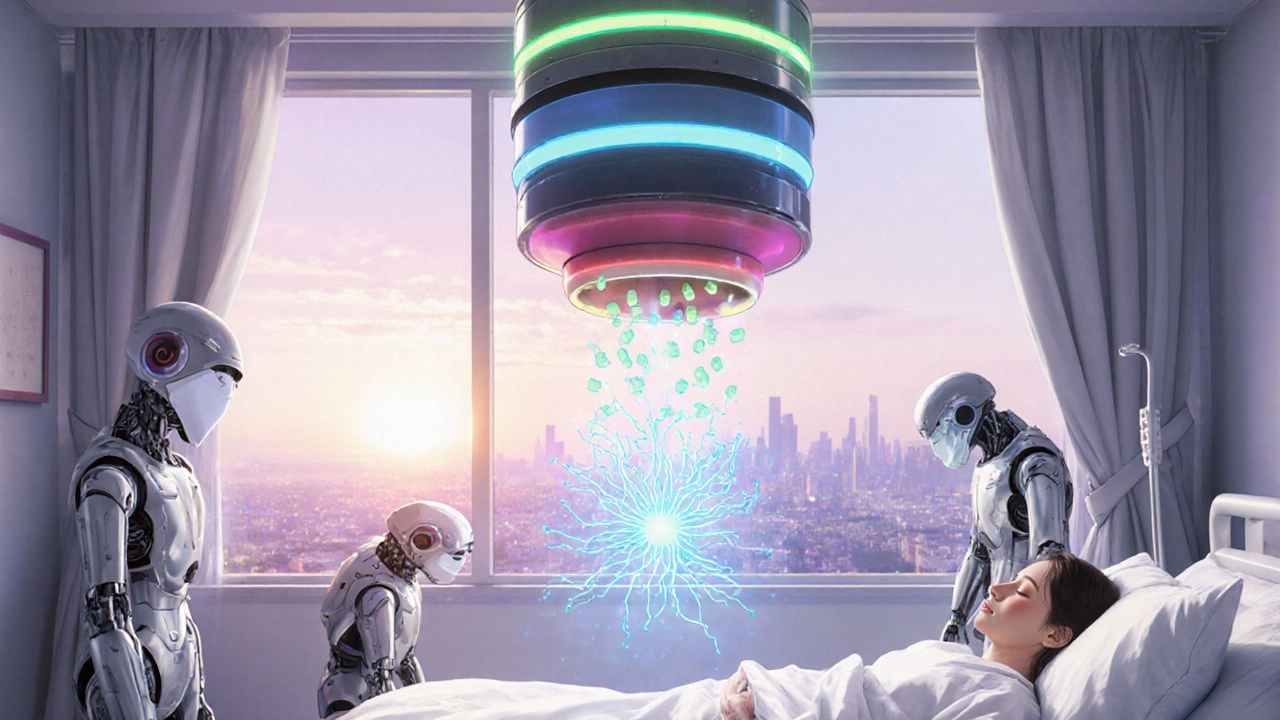Imagine taking a pill for your depression, and within an hour, you feel a surge of energy-then, by mid-afternoon, you're crashing again. Now imagine another pill that keeps you steady all day, no spikes, no crashes. That’s the difference between extended-release and immediate-release medications. It’s not just about how often you take your pill-it’s about how your body handles the drug over time, and getting it wrong can be dangerous.
How Extended-Release and Immediate-Release Work
| Feature | Immediate-Release (IR) | Extended-Release (ER) |
|---|---|---|
| Time to peak effect | 30-90 minutes | 2-4 hours |
| Duration of action | 4-8 hours | 12-24 hours |
| Dosing frequency | 2-4 times daily | 1-2 times daily |
| Plasma concentration profile | Sharp peaks and deep troughs | Smooth, steady levels |
| Release mechanism | Simple dissolution in stomach | Matrix systems, osmotic pumps, coatings |
Immediate-release pills are the classic kind you’ve probably used for years. You swallow them, and the drug dissolves fast-usually within 15 to 30 minutes. Your body absorbs it quickly, and you feel the effect soon after. That’s great for things like pain relief or anxiety that hit suddenly. But it also means the drug level in your blood spikes high, then drops fast. That rollercoaster can cause side effects like dizziness, nausea, or even seizures in extreme cases.
Extended-release pills are built differently. They don’t just melt in your stomach. They use special coatings, tiny pellets, or gel matrices that slowly release the drug over hours. Some, like Concerta for ADHD, use an osmotic pump that pushes the medicine out at a steady rate. Others, like Metformin ER, use a hydrophilic matrix that swells and lets the drug leak out gradually. The goal? Keep your blood levels stable so you don’t get the highs and lows that come with IR.
Why Timing Affects Your Safety
One of the biggest dangers with ER medications is assuming they work like IR. People often take an extra dose because they don’t feel anything right away. But ER drugs take hours to kick in. If you take another pill thinking it didn’t work, you could end up with too much drug in your system-especially dangerous with medications like bupropion, where blood levels over 350 ng/mL raise seizure risk.
A 2021 report from the National Poison Data System found that overdoses involving extended-release bupropion required hospital stays two to three times longer than IR overdoses. Why? Because the drug keeps releasing for up to 48 hours. You can’t just wait it out-the body is still getting more medicine long after you took the last pill.
And here’s something most patients don’t know: you should never crush, split, or chew extended-release pills. The FDA issued a safety warning in 2020 about this exact issue with opioids, but it applies to many other drugs too. Crushing an ER tablet can release the entire dose at once-like turning a slow drip into a firehose. In one case, a patient crushed their extended-release oxycodone tablet and died within hours from respiratory failure.
Even if the pill looks like it’s scored, don’t assume it’s safe to split. Venlafaxine XR, for example, is often mistaken as splittable, but splitting it ruins the release mechanism. Pharmacists report that 23% of medication errors with ER drugs involve improper splitting or chewing.

When ER Is Better-And When IR Wins
Extended-release isn’t always the best choice. It’s ideal for chronic conditions where you need steady control: high blood pressure, depression, ADHD, diabetes. A 2022 study in JAMA Internal Medicine followed 15,000 people on hypertension meds. Those on ER versions had a 22% higher adherence rate-78% took their pills consistently, compared to just 56% on IR. Fewer doses mean fewer missed pills.
Take Adderall. The IR version lasts 4 to 6 hours, meaning kids with ADHD often need a midday dose at school. Adderall XR lasts 10 to 12 hours-no school nurse needed. Patients on Reddit’s ADHD forum say they prefer XR for daily focus because it avoids the “2 p.m. crash” that comes with IR. One user wrote: “I keep a 5mg IR tab for presentations. I need that instant boost, but XR is my everyday.”
But IR has its place. If you’re managing breakthrough pain, IR opioids give you relief fast. If you’re starting a new antidepressant, doctors often begin with IR to fine-tune the dose. You can’t adjust ER doses easily-you’re stuck with whatever release profile the pill was designed for. And if you’re having a panic attack, you don’t want to wait two hours for your medication to work.
Even the timing of your dose matters. Some ER medications, like delayed-release mesalamine, only activate in the lower intestine. If you take them with a big meal or antacids, the pH changes, and the drug might not release where it’s supposed to. That’s why your pharmacist might tell you to take it on an empty stomach.
Cost, Convenience, and Real-World Trade-Offs
ER versions usually cost more. Adderall XR runs $350-$450 for 30 capsules; the IR version is $280-$380. That’s a 15-25% premium. But when you factor in fewer doctor visits, fewer side effects, and better adherence, ER often saves money long-term.
Patients on metoprolol ER report 32% fewer dizziness episodes than those on IR. Satisfaction scores are higher: 4.2 out of 5 versus 3.5. But 27% of those same patients complained that ER didn’t help fast enough during acute anxiety. They felt stuck-no quick fix when they needed it.
And here’s the catch: ER medications take longer to reach steady state. While IR drugs stabilize in 3 to 5 days, ER can take 7 to 10. That means if you switch from IR to ER, you might feel worse for a week before you feel better. Patients often think the new pill isn’t working and go back to the old one-or take extra doses. That’s how accidental overdoses happen.

What You Need to Know Before Taking Either
- If you’re switching from IR to ER, give it at least a week before deciding if it’s working.
- Never crush, split, or chew an ER pill-even if it looks like it should be split.
- If you miss a dose of ER, don’t double up. Take it as soon as you remember, then go back to your regular schedule.
- If you have gastroparesis, delayed stomach emptying, or severe digestive issues, talk to your doctor. ER drugs can absorb unpredictably in these cases.
- Always check the label. 98% of ER products have a warning about altering the dosage form. If it says “do not crush,” don’t.
- Keep IR versions on hand if you’re on ER for chronic conditions-just in case you need a quick boost.
What’s Next for Medication Delivery?
The future of pills is getting smarter. Companies are developing abuse-deterrent ER formulations that turn to gel when crushed-like Impax’s Aversion® tech used in some ADHD meds. These have cut abuse rates by nearly half.
MIT researchers are testing 3D-printed “polypills” that release different drugs at precise times-perfect for older adults taking five or more meds a day. These aren’t available yet, but they show where the field is headed: personalized timing, not one-size-fits-all.
For now, the choice between ER and IR comes down to your condition, lifestyle, and how your body responds. It’s not about which is “better.” It’s about which is right for you.
Can I split an extended-release pill if it’s scored?
No-even if a pill looks scored, it doesn’t mean it’s safe to split. Many extended-release pills use complex coatings or matrix systems that are ruined by splitting. Crushing or splitting can release the entire dose at once, leading to dangerous spikes in drug levels. Always check the prescribing information or ask your pharmacist before splitting any pill.
Why do I feel worse when switching from immediate-release to extended-release?
It can take 7 to 10 days for extended-release medications to reach steady levels in your blood, compared to 3 to 5 days for immediate-release. During that time, your body is adjusting to slower, steadier delivery. You might feel sluggish, moody, or even more symptomatic before the ER version starts working properly. Don’t assume it’s not working-give it time, and talk to your doctor if symptoms worsen.
Is extended-release always safer than immediate-release?
Not always. ER reduces side effects from peaks and troughs, which is safer for long-term use. But in overdose situations, ER can be more dangerous because the drug keeps releasing for hours or even days. Immediate-release, while riskier for daily side effects, is easier to manage in emergencies because the drug clears faster. The safest option depends on your condition, how you take it, and whether you follow dosing instructions.
Can I take extended-release medication with food?
It depends on the drug. Some ER meds, like metformin, work better with food to reduce stomach upset. Others, like delayed-release mesalamine, require an empty stomach so they reach the right part of the intestine. Always follow the label or your pharmacist’s instructions. Eating the wrong way can delay absorption or cause the drug to release too early or too late.
What should I do if I miss a dose of my extended-release medication?
If you miss a dose, take it as soon as you remember-unless it’s close to your next scheduled dose. Never double up to make up for a missed dose. With ER medications, taking too much at once can cause dangerous spikes. If you’re unsure, call your pharmacist or doctor. They can help you adjust your schedule safely.

David Cusack
November 21, 2025 AT 14:33Let’s be real-ER meds are just Big Pharma’s way of making you pay more for the same drug, wrapped in a fancy coating. I’ve been on bupropion ER for three years, and I swear I feel more stable… but also more like a zombie. And yes, I’ve crushed one. Once. Didn’t die. Just felt like I’d swallowed a lightning bolt.
Willie Doherty
November 21, 2025 AT 18:45Statistical analysis of adherence rates cited in the post (78% vs. 56%) reveals a potential selection bias-patients prescribed ER are more likely to be clinically stable, monitored, and compliant by default. The causal inference that ER improves adherence is thus confounded. Furthermore, plasma concentration profiles are rarely linear; pharmacokinetic modeling suggests non-uniform absorption in 37% of GI-disturbed populations. The FDA’s warning on crushing is valid-but only for non-porous matrix systems. Osmotic pumps remain intact under mechanical stress, unless compromised by enzymatic degradation.